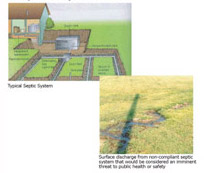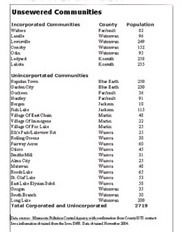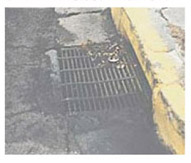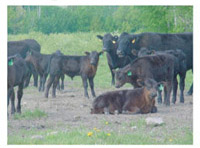

Septic Systems
There are approximately 14,038 individual septic systems in the basin. Of these, approximately 39% are estimated to be listed as an imminent threat to public health or safety (ITPHS). ITPHS listing indicates the potential to immediately and adversely affect or threaten public health or safety. At a minimum, this includes ground surface or surface water discharges and sewage backup into a dwelling or other establishment.
Human sewage in waterways pose a particular threat because human fecal coliform often contains viruses and pathogens dangerous to human health.

Unsewered Communities
All unsewered communities are not equal. Some or all of the homes and businesses in unsewered communities may have inadequate wastewater treatment and as such may be a source of contamination. In some cases an unsewered community may have a common collection system that carries untreated wastewater directly into nearby waterways.

Wastewater Treatment Plants
Municipal wastewater systems can also be a source of fecal contamination. These facilities are required by state rule to meet a discharge limit of 200 organisms/100 mL fecal coliform concentration. This is accomplished through disinfection of the wastewater at the final treatment stage, through chlorination or equivalent process.
Permitted wastewater treatment plants are required to monitor their effluent. Violations of the discharge limit/standard do occur. From 2000-2004, records indicate 44 emergency bypasses of inadequately treated sewage and 24 other violations within the basin.

Stormwater Runoff
Fecal coliform bacteria and other pollutant concentrations in urban runoff can be as great or greater than those found in cropland, grazed pasture, and feedlot runoff (USEPA, 2001).


Open Feedlots & Land Application of Manure
There are nearly 2,300 livestock facilities in the basin both large and small scale. About 210 of these house more than 1,000 animal units (AU). The majority of facilities are confined operations with little runoff to surface water. Still, there is a significant number of open feedlots, some of which have pollution problems and pose a risk of fecal contamination.
Land application of manure can be a major source of fecal contamination. Common manure spreading practices include broadcasting, surface application with incorporation, and injection. The significance of this source depends on how the manure application is managed, the rate and time of application, observance of setbacks from surface water, timely incorporation to avoid major runoff following a rain, use of riparian buffer strips on manured fields, residue management to retard surface runoff, and other practices.

Over-grazed Pasture
Overgrazed pastures near streams or waterways can be a source of bacterial contamination. Heavy grazing can compact soil, deplete plant growth, and produce bare spots that are prone to erosion and can carry fecal material into waterways.
Minnesota River Basin Data Center | Minnesota State University, Mankato
184 Trafton Science Center S, Mankato, MN 56001 | Phone: (507)389-5492 | FAX: (507)389-5493